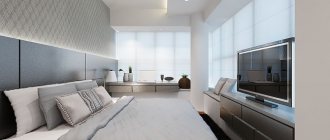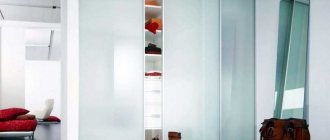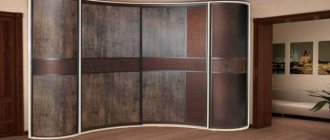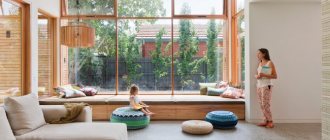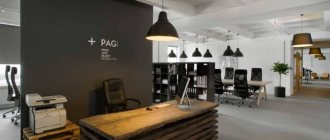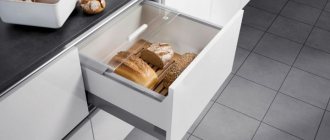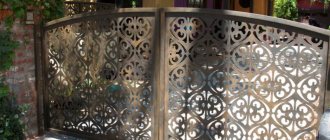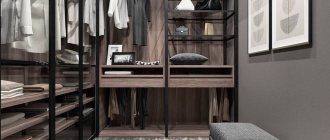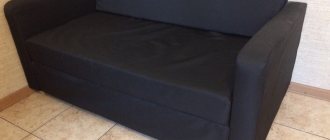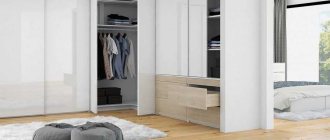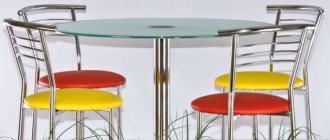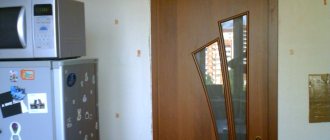This is a ceiling consisting of caissons - “boxes”. The recesses are formed by several intersecting beams and are decorated with stained glass, colored paints, ornaments, paintings, stucco, built-in or pendant lamps. The coffered ceiling consists of a technical base and decorative elements. The base is the substrate and frame. Cornices, borders, platbands and sockets are attached to them.
Photo: houseofdream.com.ua
What does coffered ceiling mean?
This is a finishing method in which the surface is divided into cells by protruding beams. The result is niches of different shapes, often square. The name comes from the French word “caisson”, which means “box”.
Stone and wooden coffered ceilings appeared in antiquity. This arrangement was dictated by necessity: the beams served as part of the supporting structure. Now the design plays a decorative role.
Advantages of caissons:
- mask the unevenness of the rough floor;
- hide wires and other communications;
- reduce noise levels;
- reduce heat loss (especially with an additional insulating layer);
- give the room a noble look;
- combined with different styles of decoration.
Disadvantages of coffered ceilings:
- complex installation;
- high price;
- reducing the height of the room (recommended for rooms from 2.8 meters).
What can caissons be made from?
Materials differ in properties and processing features. Installation is also a little different.
Drywall
GCR is a relatively inexpensive and at the same time environmentally friendly material. It is easy to create structures of different sizes and install lamps from it. Difficulties arise when joining drywall. And the caissons should be as even as possible, only then will the impression of a solid structure be created.
Ceiling installation takes place in several stages. First, a frame is built from aluminum guides. It is sheathed with cut plasterboard sheets. Then the joints are puttied, primed and painted. Coffered plasterboard ceilings can be decorated with stucco.
Peculiarities! Sometimes only imitation beams are made from gypsum plasterboard. Plasters of gypsum or polyurethane are installed between them.
Tree
This is a traditional material that gives the interior respectability and luxury. Wooden coffered ceilings can be used in bedrooms and children's rooms. Disadvantages include high price and weight.
For finishing, noble species are chosen: oak, walnut, ash, beech, cherry, mahogany, etc. Wooden blocks are used to create the frame. They are sheathed with boards and fill the bottom of the ceiling niches. Sometimes natural wood is combined with MDF, chipboard or plywood. For decoration, thin carved slats are added (along the perimeter of the ceiling and along the beams).
MDF
The material looks like natural wood, but is lighter and cheaper. Therefore, the ceiling is easier to install, and this type of finish is more affordable. As a rule, ready-made panels and strips are used.
The ceiling is mounted in two ways:
- on profiles (the design allows the installation of recessed lamps);
- directly onto the rough base (the surface must be flat).
Advice! When combining materials, it is better to choose those that are as close in shade as possible or, conversely, use contrasting colors.
Gypsum
Available in the form of finished panels covered with carvings and stucco. Various design options are available. Classical, Baroque, Empire, Gothic, etc. styles are used. Floral, geometric and even heraldic motifs are found in the design. Disadvantages include heavy weight and fragility.
The boards are used alone or in combination with plasterboard (on high ceilings). Before installation, the back surface is wetted and glue (PVA or specialized for plaster) is applied. The caisson is pressed to the ceiling and additionally secured with self-tapping screws, since gypsum boards are too heavy to be fixed only with glue. The holes for them are drilled in advance, and the caps are covered with putty after installation.
Read more: Plaster stucco on the ceiling
Products made of polyurethane
Caissons look like plaster ones, but are much lighter. The material does not absorb water and does not burn, is strong and durable. Coffered polyurethane ceilings are suitable for damp rooms and unheated houses. The surface can be painted. Tinting like gold or patina looks interesting.
Polyurethane boards are used alone or in combination with plasterboard. They are glued to the ceiling, so the surface must be flat.
Attention! Caissons for ceilings made of foam plastic, at first glance, look like polyurethane ones. But the material is fragile and short-lived. During installation, it is difficult to achieve even joints, and grains are often visible on the surface of the foam. As a result, the finish looks cheaper and collects dust.
Advantages and disadvantages of wooden
Modern coffered ceilings are made from various materials:
- wood;
- MDF;
- drywall;
- construction cardboard;
- polyurethane;
- aerated concrete blocks;
- their combinations.
In this series, structures made of solid wood or solid wood occupy a special place:
- They have excellent decorative properties. Even in the simplest version, the texture of the treated wood looks attractive. In design projects, various decorative options are used - carvings, inlays, mosaics made from different species, inserts from other materials that can decorate any interior.
- Durable, most industrial production kits are designed for a service life of 20-50 years, while maintaining an attractive appearance and performance.
- They are absolutely environmentally friendly; with the right choice of breeds, they not only do not have a negative impact on health, but are also able to saturate the air with useful substances.
- They have excellent thermal insulation properties and allow for discreet installation of additional layers of thermal insulation.
- Improves the sound insulation of the room and the acoustics inside it.
They are also characterized by the general advantages of caisson structures:
- Simplicity of preparatory work, no requirements for the quality of the primary coating that will be hidden under the structure;
- Masking of communications;
- Ease of placement of additional lighting sources;
- Possibility of changing the style and color of the finish without major dismantling and installation work.
There are also some shortcomings, the main ones being:
- Complexity of installation, the need to use a whole set of tools. Not everyone can cope with such a task on their own;
- High price. Even a set of materials will be quite expensive, but if you entrust the work to specialists, the costs will almost double;
- Significant production time. Only standard factory-produced systems can be installed relatively quickly. With a custom order, when craftsmen make and adjust literally every detail on site, it can take weeks to finish one room.
Caisson shapes
Most often they make square cells. Also found:
- rectangular (look good in elongated rooms);
- in the form of rhombuses (formed by beams crossing the room diagonally, visually adding space);
- in the shape of honeycombs (hexagons; this option is a little more difficult to install).
Sometimes the central caisson is made larger in size. It can be round, square, rectangular or oval. Often a chandelier is hung in the “main” element.
Color solutions
A traditional white ceiling increases the height of the room and adds air to the interior. Thanks to the caissons, the decoration does not look boring.
Brown, including natural wood, looks noble and cozy. Black adds rigor and aristocracy.
Important! Dark colors are only suitable for high ceilings, as they visually make the room lower. In this case, it is better to choose light colors for the floor or walls, otherwise the room will be too gloomy. The lighting is made brighter, since dark tones partially mute it.
Pastel shades add variety to the interior, but do not lower the ceiling. Light blue and soft turquoise are suitable for Scandinavian or Mediterranean style. For Provence, other light colors are also used (lavender, cream, pistachio).
An interesting technique is a combination of contrasting colors for the coffered ceilings. As a rule, beams are highlighted in a dark color, and niches remain light. The overall level does not visually drop, but the ceiling looks original and attracts attention. A more discreet option is white beams and pastel caissons. The difference in height can be emphasized by installing LED lighting behind the beams.
Lighting ideas
Properly selected lighting will help completely transform a room.
With chandelier
Various chandeliers further emphasize the beauty, sophistication and elegance of the ceiling structure and make it the most important decorative element in the room.
Backlit
To prevent the ceiling from looking dull and inexpressive, it is better to equip it with additional lighting around the perimeter, which will effectively emphasize the shape and size of the cell.
How to make a coffered ceiling with your own hands
For each material, the technology is slightly different. Installation of coffered wooden ceilings is considered difficult, since natural wood requires certain skills in operation. Gypsum panels are also not easy to work with - the material is heavy and fragile. It is much easier to make coffered MDF ceilings with your own hands. In addition, this option is more practical: it lasts a long time and is easy to care for.
For installation you will need:
- aluminum U-shaped profiles for drywall;
- pendants;
- crab connectors;
- guide strips;
- panels;
- laminated canvas (to cover the indentations along the edges);
- fillets for decoration;
- fastener
At the first stage, markings are applied to the ceiling and walls. In this case, you need to take into account the width of the profiles. The distance between them depends on the size of the panels (600 x 600 or 900 x 900 mm).
Advice! Markings start from the center, not from the wall. Then the finish is symmetrical.
Leave at least 125 mm between the ceiling and the profiles. The gap will be needed to install the caisson. Then, focusing on the grid, profiles are installed. They are placed with the curved edges down and connected using crabs.
The next step is installing short strips. They are pre-cut to cell size (516 mm for small panels and 816 for large ones). During installation, the part is simply snapped into the profile. The planks are placed in parallel rows in one direction.
After this, the caissons are installed. The plate is inserted into the cell and installed on short guides.
Then long guides are cut. For caissons with a side of 600 mm you will need 2316 mm, and for 900 - 2610. The planks are installed perpendicular to the short ones.
If the distance left at the walls is less than the size of the cells, the gap is covered with laminated cloth. The sheets are trimmed and laid flush with the slats. The final stage is attaching the fillets around the perimeter. This creates a smooth transition to the walls, and the finish takes on a finished look.
Attention! Before installation, you need to consider the lighting system. The devices are located in the center of the cells. Wires are laid in advance and holes are drilled in the caissons. After assembling the ceiling, the lamps are installed and connected.
Coffered ceilings in the interior
This decoration is appropriate in different rooms. The living room with wooden coffers becomes a cozy place to gather the whole family and receive guests. The kitchen gets a more formal and formal look. Here it is better to use polyurethane caissons that are not afraid of moisture. A calm, dim finish is suitable for the bedroom. Natural wood tones, white, and pastel shades are used. The coffered ceiling will add rigor and aristocracy to the office. You can use dark colors or contrasting finishes.
A coffered ceiling is more difficult to install than a regular suspended ceiling. But the result is outstanding.
Design options
Historically, there have been several types of coffered ceilings. Today their number has increased significantly; The following objects have become in demand:
Stained glass
It amazes with its beauty and grace. Stained glass windows with exquisite ornaments or paintings make the coffered structure lighter, brighter and more expensive.
Combined
A double coffered ceiling in combination with a glossy or matte stretch fabric is always a winning and elegant option.
With stucco
Structures decorated with stucco have an aesthetic appearance, perfectly highlight and transform the ceiling space, giving it relief and an antique effect.
Carved
Makes the interior luxurious and solid. Patterned models decorated with Bulgarian carvings will add originality to the room and go perfectly with various styles, such as classic, baroque or modern.
